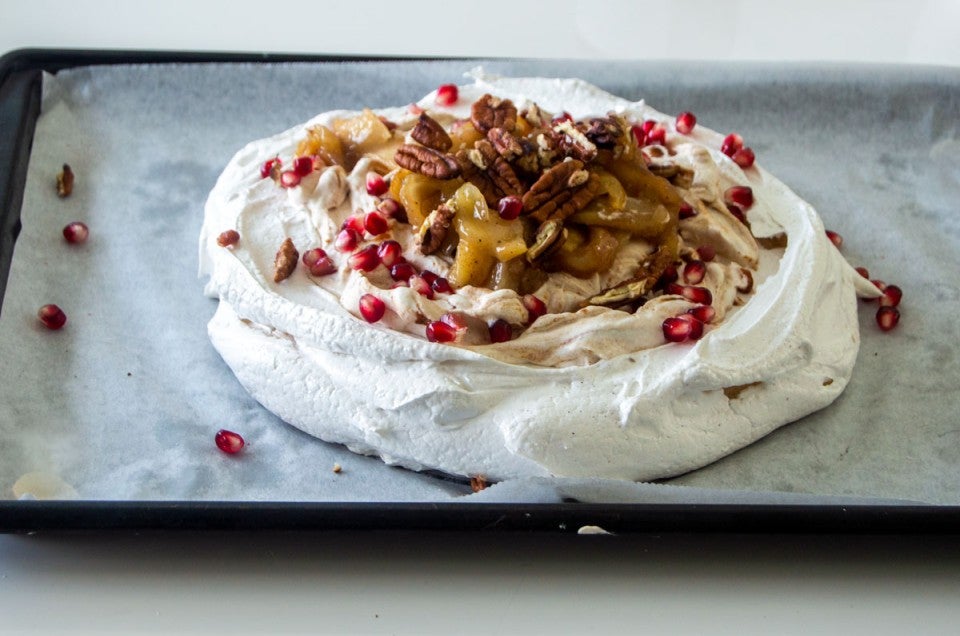Think pavlovas are just for summer? Think again.
Cold weather doesn’t mean goodbye to pavlovas — it just opens the door to new spins.


Every year when summer draws to a close, I get a little sad. Not because I’ll miss beach days, or sandals, or picnics. But because it’s the end of pavlova season. No more ripe farmers market berries to scatter atop mounds of fresh whipped cream, or juicy peaches to adorn shatteringly crisp meringue.
Except … what if the end of summer didn’t signal the end of pavlovas? What if it just meant a new kind of beginning?
This fall, I realized that pavlova could not only be an unexpected dessert for colder months, but in some ways it's ideally suited to them. This meringue dessert is classically topped with fruit and whipped cream, but you don't have to let that hold you back. Try other toppings like crumbled cookies, toasted nuts, or candied ginger. Or if you want to stick with fruit, embrace apples, pears, and cranberries. And remember: Meringue and whipped cream are basically a blank canvas on which to showcase a range of seasonal flavors, from maple to spices.

It’s not just the wide variety of fall flavors that make pavlovas wonderful to bake this season, either — they’re also a welcome contrast to the heartier dinners and feasts we find ourselves eating this time of year. Think about the end of an over-the-top Thanksgiving meal or comforting supper. Won’t you be ready for a light-as-air dessert to cap it all off?
The season for pavlovas is now (and always). If you’re ready to embrace it with me, here’s how to create a pavlova perfectly suited for fall and winter.
Years ago, I came across a tip from baker Alice Medrich about swirling nut butter into meringue. This is a lovely addition to fall pavlovas, and got me thinking of other similar ways to flavor meringue.
For Alice's method, simply dollop several scoops of nut butter on top of the stiff meringue and do a few quick folds with a spatula until it looks streaked. The nut butter adds a richness and welcome contrast to the overall sweetness of the meringue. Plus it’s a grounding flavor that works well with cold weather ingredients and spices.
Which, speaking of, you could also add here: Try sprinkling cozy spices into the meringue as it whips. Then, you can echo those flavors through the other components (keep reading!).

A simple sugar swap is also a nice option to winter-ize your meringue. Instead of neutral granulated sugar, use brown sugar or coconut sugar for a darker flavor profile to complement seasonal toppings.
Tips for your meringue:
Swirl in nut butters like almond or hazelnut
Sprinkle in spices like nutmeg or ginger, or a seasonal spice blend
Use coconut sugar or brown sugar for depth of flavor
Building off the flavors in your meringue and ultimate choice of topping, think about complementary flavors that could be incorporated into the whipped cream here. Similar to the meringue, you could add a hefty dose of pumpkin spice or apple pie spice, or your own combination of cinnamon, cardamom, ginger, cloves, and more.

In addition, try using maple syrup, boiled cider, molasses, or other add-ins to flavor your cream. Avoid using too much sweetener, though; barely sweetened is the way to go, since the meringue is already quite sweet. With that in mind, try using maple extract instead of syrup for all the flavor, none of the excess sweetness.
Flavor whipped cream with:
Maple syrup or maple extract
A dash of bourbon or rum
Molasses
Spices like cinnamon, cloves, cardamom, and more
If you want to stick with a traditional fruit topping, you can find plenty of inspiration this time of year — it’ll just require a little extra effort to prepare, unlike summer fruits that can be added to pavlova fresh from the market.
Trying making cinnamon-baked apples or red wine-poached pears. Cranberries stewed with sugar and orange zest are also nice here, and their tartness is a good contrast to the sweet meringue. Or take the simple (but no less tasty!) route and pop open a jar of apple or pumpkin butter.

Another option: Get even more creative with toppings, expanding beyond fruit to crushed gingerbread cookies or crumbled halvah, or even flavorful spreads like Nutella or tahini. The possibilities are endless and don't have to be limited to just fruit, so let your tastebuds guide you.
Try these toppings:
Cinnamon-baked apples (use a light hand with the sugar)
Red wine-poached pears
Apple or pumpkin butter (the less sweet, the better)
Stewed cranberries
Crushed cookies (chocolate or gingerbread are great options)
Nutella or other flavorful spreads
Many summer pavlovas are finished with a simple garnish like confectioners’ sugar or mint leaves. In colder months, however, I like to take things a step further by adding seasonal finishes that make this dessert just a little more decadent.

Salted caramel sauce would be irresistible here — take it up a notch by making this rosemary version (and definitely include the salt to cut some of the sweetness!). For some welcome texture, sprinkle on toasted or candied nuts, or pomegranate seeds for a tart burst of flavor. If you like to put in a little extra effort, sugared cranberries would be stunning. (Check out the Baker's Tips at the bottom of this Cranberry Chiffon Pie recipe to see how to make them.)
Finish your pavlova with:
Salted caramel sauce
Toasted or candied nuts
Pomegranate seeds
Sugared cranberries
Butterscotch sauce
Candied ginger

The main takeaway here: You can think of our pavlova recipe as a starting point, then draw inspiration from fall flavors and cold weather staples to create a stunning dessert for the season.
Cover photo by Rossi Anastopoulo.

